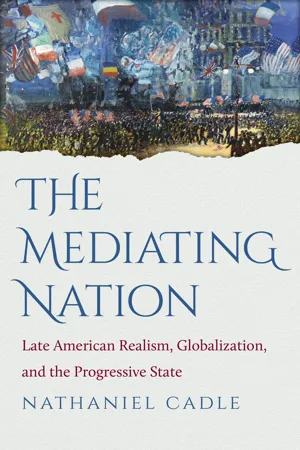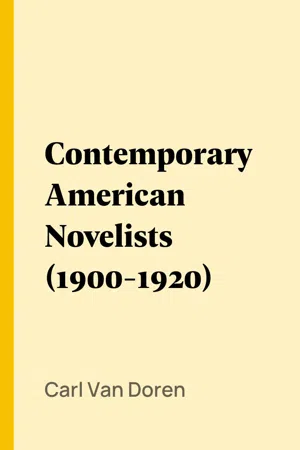Literature
Local Color Novel
A Local Color Novel is a type of fiction that emphasizes the unique customs, dialects, landscapes, and characters of a particular region or community. These novels often depict the everyday lives of ordinary people and aim to capture the essence of a specific time and place.
Written by Perlego with AI-assistance
Related key terms
Related key terms
1 of 4
Related key terms
1 of 3
3 Key excerpts on "Local Color Novel"
- eBook - ePub
Appalachia on Our Mind
The Southern Mountains and Mountaineers in the American Consciousness, 1870-1920
- Henry D. Shapiro(Author)
- 2014(Publication Date)
- The University of North Carolina Press(Publisher)
9This is not to say that the local-color “movement” did not possess characteristics which set it off from other literary modes. It was descriptive rather than analytical. It was short rather than long. It was enormously popular. It aided in the sale of the literary magazines in which it appeared, bolstered the fortunes of those publishing houses which brought out volumes of collected stories and sketches, and established the literary reputations of innumerable young and middle-aged writers. It was popular also in the sense that it was consciously not directed at a limited readership of sophisticates and/or aesthetes. These very characteristics point to the central fact about local-color literature—it emerged as a response to the existence of a substantial market for descriptive pieces which the readers of the new middle-class monthlies would find interesting.Long after local-color writing had gone out of vogue, Hamlin Garland noted that “authors write for publication,” and that “the conditions which govern the distribution and sale of books and magazines have more to do with determining the form and spirit of a nation’s literature than most historians are willing to admit,” and acknowledged, perhaps ruefully, that “authorship as an art may be free of such limitations, but in so far as it approaches a trade it must conform.”10 Few historians have been willing to accept so empirical an understanding of the process of literary creation, and few modern authors are free of that sense of the late nineteenth century as a golden age in literature which prohibits them from generalizing from their own experience in the present to understand the local colorists as practitioners of a craft. Yet the writers, editors, and publishers of the 1870s and 1880s knew quite well what local-color writing was about, and one at least remembered very clearly the practical circumstances of publishing in those days. “The fact that English fiction in serial form was ... of such eminence as to command the preference of readers, and therefore a larger space in the pages of the Magazine, caused special stress to be laid upon the short stories of American writers.”11 - eBook - ePub
The Mediating Nation
Late American Realism, Globalization, and the Progressive State
- Nathaniel Cadle(Author)
- 2014(Publication Date)
- The University of North Carolina Press(Publisher)
Richard Brodhead has argued that local color’s “heavily conventionalized formulas” served as an enabling constraint, which worked to give first-time writers, including women, African Americans, and working-class people, “literary access in America.” 11 If these aspiring writers agreed to fulfill the stylistic and generic expectations of local color, then their work was more likely to appear in the national magazines of the day, thereby giving them relatively easy access to the publishing industry. As Amy Kaplan has pointed out, however, “this profusion of literature known as regionalism or local color [also] contributed to the process of centralization or nationalization” by reassuring readers that underlying similarities bound the nation’s various regions together into a single unit. 12 Thus the paradoxes of local color operated simultaneously at the level of individual texts, which used established conventions to represent regional or ethnic differences, and at the level of the U.S. publishing industry, which used these texts to produce a more homogenous mass culture. On one hand, this chapter extends to a global level the logic of incorporation that Brodhead and Kaplan have ascribed to local color. Howells’s later fiction, including A Hazard of New Fortunes, enacts a shift toward engaging—and sometimes attempting to resolve the problems of—such global processes as immigration and the circulation of radical art and politics, which were altering the social fabric of the United States. Likewise, his later criticism, including Criticism and Fiction, implicitly casts Howells himself not only as an arbiter of American literary taste, but as a gatekeeper of world literature. Howells’s assumption that the techniques of local color that American authors practiced could be adopted by writers in other countries as a means of accessing the American and, by extension, the world market is entirely consistent with the picture of the U.S. literary industry that Brodhead paints - eBook - ePub
- Carl Van Doren(Author)
- 2004(Publication Date)
- Perlego(Publisher)
The eager popular demand for these brevities does not entirely account for the failure of the type to go beyond its first experimental stage. The defects of local color inhere in the constitution of the cult itself, which, as its name suggests, thought first of color and then of form, first of the piquant surfaces and then—if at all—of the stubborn deeps of human life. In a sense, the local colorists were all pioneers: they explored the older communities as solicitously as they did the new, but they most of them came earliest in some field or other and found—or thought—it necessary to clear the top of the soil before they sank shaft or spade into it. Moreover, they accepted almost without challenge the current inhibitions of gentility, reticence, cheerfulness. They confined themselves to the emotions and the ideas and the language, for the most part, of the respectable; they disregarded the stormier or stealthier behavior of mankind or veiled it with discreet periphrasis; they sweetened their narratives wherever possible with a brimming optimism nicely tinctured with amiable sentiments. Poetic justice prospered and happy endings were orthodox. To a remarkable extent the local colorists passed by the immediate problems of Americans—social, theological, political, economic; nor did they frequently rise above the local to the universal. They were, in short, ordinarily provincial, without, however, the rude durability or the homely truthfulness of provincialism at its best.To reflect upon the achievements of this dwindling cult is to discover that it invented few memorable plots, devised almost no new styles, created little that was genuinely original in its modes of truth or beauty, and even added but the scantiest handful of characters to the great gallery of the imagination. What local color did was to fit obliging fiction to resisting fact in so many native regions that the entire country came in some degree to see itself through literary eyes and therefore in some degree to feel civilized by the sight. This is, indeed, one of the important processes of civilization. But in this case it was limited in its influence by the habits of vision which the local colorists had. They scrutinized their world at the instigation of benevolence rather than at that of intelligence; they felt it with friendship rather than with passion. And because of their limitations of intelligence and passion they fell naturally into routine ways and both saw and represented in accordance with this or that prevailing formula. Herein they were powerfully confirmed by the pressure of editors and a public who wanted each writer to continue in the channel of his happiest success and not to disappoint them by new departures. Not only did this result in confining individuals to a single channel each but it resulted in the convergence of all of them into a few broad and shallow streams.An excellent example may be found in the flourishing cycle of stories which, while Bret Harte was celebrating California, grew up about the life of Southern plantations before the war. The mood of most of these was of course elegiac and the motive was to show how much splendor had perished in the downfall of the old régime. Over and over they repeated the same themes: how an irascible planter refuses to allow his daughter to marry the youth of her choice and how true love finds a way; how a beguiling Southern maiden has to choose between lovers and gives her hand and heart to him who is stoutest in his adherence to the Confederacy; how, now and then, love crosses the lines and a Confederate girl magnanimously, though only after a desperate struggle with herself, marries a Union officer who has saved the old plantation from a marauding band of Union soldiers; how a pair of ancient slaves cling to their duty during the appalling years and will not presume upon their freedom even when it comes; how the gentry, though menaced by a riffraff of poor whites, nevertheless hold their heads high and shine brightly through the gloom; how some former planter and everlasting colonel declines to be reconstructed by events and passes the remainder of his years as a courageous, bibulous, orgulous simulacrum of his once thriving self. Mr. Page's In Ole Virginia and F. Hopkinson Smith's Colonel Carter of Cartersville
Index pages curate the most relevant extracts from our library of academic textbooks. They’ve been created using an in-house natural language model (NLM), each adding context and meaning to key research topics.
Explore more topic indexes
Explore more topic indexes
1 of 6
Explore more topic indexes
1 of 4


